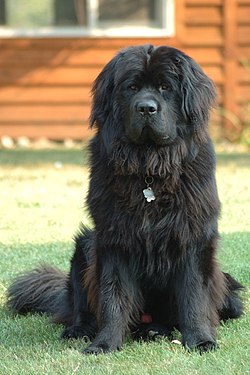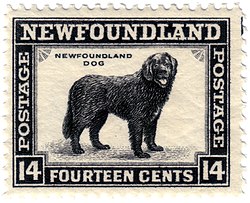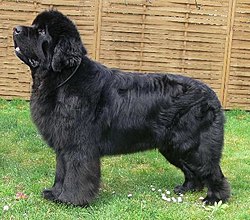Napoleon the Wonder Dog
A famous all-black Newfoundland performed as the star attraction in Van Hare's Magic Circus from 1862 and for many years thereafter in one of England's founding circus acts, traveling throughout Europe. The circus dog was known as the "Thousand Guinea Dog Napoleon" or "Napoleon the Wonder Dog". The circus owner, G. Van Hare, trained other Newfoundland dogs to perform a steeplechase routine with baboons dressed up as jockeys to ride them. Nonetheless, his "wizard dog" Napoleon was his favourite and held a special position in the Magic Circus. Napoleon would compete at jumping against human rivals, leaping over horses from a springboard, and dancing to music. [28] [29]
Napoleon the Wonder Dog became a wildly popular act in London from his debut at the Pavilion Theatre on April 4, 1862, and onward until his untimely death many years later when he slipped and fell during a circus practice session. At the peak of his fame, his performance was described in London's Illustrated Sporting News and Theatrical and Musical Review as follows: "Synopsis of his entertainment:— He spells his own name with letters, also that of the Prince of Wales; and when he is asked what he would say of her Most Gracious Majesty, he puts down letters to form 'God save the Queen.' He plays any gentleman a game of cards and performs the celebrated three-card trick upon which his master backs him at 100 to 1. Also 'The Disappearance,' a la Robin. He performs in a circus the same as a trick horse, en liberté, giving the Spanish trot to music, also leaping over bars, through balloons, with numerous other tricks of a most interesting character." [30]
When Napoleon the Wonder Dog died at the age of 12 years old, his death was announced in a number of British newspapers, including the Sheffield Daily Telegraph, which mentioned the loss on May 5, 1868, as follows: "DEATH OF A CELEBRATED FOUR-FOOTED ARTISTE. — Mr. Van Hare's renowned dog, Napoleon, designated 'The Wizard Dog,' died on 24th ult., aged twelve years. He was a noble specimen of the Newfoundland breed (weighing near 200 lbs.) for which he took the prize at the first Agricultural Hall Dog Show. Besides his magnificent appearance and symmetry, he was the most extraordinary sagacious and highly-trained animal ever known. He is now being preserved and beautifully mounted by the celebrated naturalist, Mr. Edwin Ward. — Era." [31]
















